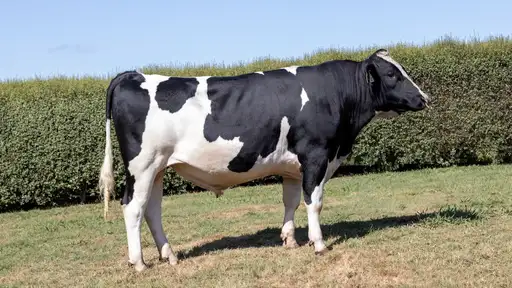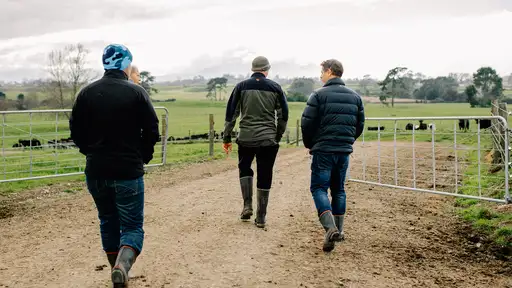Their focus on their cows has never since wavered. Here’s their remarkable herd improvement story.
This spring, with no intervention, and within 22 days of planned start of mating, Waikato based sharemilkers Simon and Aimee Player want 100% of their herd submitted to artificial insemination.
From that, they’re aiming for a 90% six-week in calf rate.
“If we miss that, I’ll be happy with 87%,” Simon says.
According to their Fertility Focus Report, in the spring of 2018 the Players achieved an 82% 6-week incalf rate; in 2017 it was 81%; in 2016 it was 70%, and; in 2015 it was 72%.
Their herd’s calving spread during the same period has more than halved, from a tad more than 15 weeks to just 7 weeks. They’re targeting a calving spread of 6 weeks next season.
Meanwhile, per-cow production figures in year one (2015) of their job began at 400kg milksolids, followed by 420kg, 450kg, 470kg, and 500kg in 2018. This year the Players are targeting 550kg milksolids per cow.
Shell-shocker for novices
The couple arrived on their current farm in 2015 with a real mix of animals they had purchased (having borrowed from family, as well as a bank that was willing to back their first foray into dairy cow ownership).
Simon wasn’t brought up on a dairy farm, but he had done a fair apprenticeship in the rural sector, having worked in dairying in both Ireland and England, as well as on a Waikato dry stock farm, followed by two years contract milking in 2013 and 2014.
“So, in 2015 I purchased five mobs comprising of a core herd of 180, plus 35 heifers, and three other smaller lots I could find that looked good for the right price,” Simon says.
That took him up to the required 270 cows he needed for the system 3 farm.
“We had a mix of big Holsteins and tiny little Jerseys. Because we’re sharemilking there’s always a need to keep the BW (Breeding Worth) up, but once we had the cows, the focus was on improving them.”
But a sudden ‘payout crash’ – that saw dairy farmer cashflows almost halve from the heady heights of more than $8 in the previous year – forced Simon to act with immediate urgency.
“You can’t make too much money in your first season at that kind of payout.
“Because we were struggling immediately culled all the later (calving) cows. I got $1200 on-the hook … that high beef price got us through. But it dropped us down to 250 cow herd. The last cow that year calved on 26 October.”
Focus on repro pays dividends
The tough start to their sharemilking career was down to unlucky timing, but Simon and Aimee believed in the fundamentals for medium- to long-term success.
Sticking to a 250-cow herd, rather than the 270-cows that had traditionally grazed the farm, an aggressive herd improvement strategy was pursued that combined stock sales, culls, and a major focus on repro, health, and selective genetics.
“In the first two years we culled and sold on calving date, and we brought the calving period shorter by two or three weeks each year,” Simon says. “I try not to cull; I prefer to sell – and to get a good price I’ll sell early.”
After the Player’s artificial insemination period, they turn to the natural mate bull for 24 days, before finishing off with short gestation length dairy for 10 days (these later cows are thereby able to recover about 10+ days-in-milk; this has helped progressively condense the calving pattern).
The heavy emphasis on a high submission rate and a high six week in-calf rate means the calving period is progressively tighter, but Simon says this is key to his production gains.

“It’s all about days-in-milk for me. I’ve done 14,000 more solids than previous sharemilkers have done under this owner for the last 10 years (despite the lower stocking rate).
Simon Player
A lot of that is down to calving spread. Last year I was 10,000 solids ahead in the first three months, so for us it’s just a case of staying ahead through the season.”
“Having a very supportive owner has enabled me to change the way some things are done and try a new approach.”
Toward the ideal herd
For this article, LIC visited the Player’s Matamata farm on August 29.
On that day, Simon pointed to the one remaining cow starting to calve that very day.
And across the race, where the main 250-strong herd grazed, the final week of August could have been mistaken for the first week of October: Bulling behaviour among multiple groups of cows was highly noticeable throughout the herd.
The Players don’t undertake intervention, preferring to manage both feed and the cows in a way that maintains good condition year-round.
Simon says he likes to have cows in great condition before mating starts, ensuring strong heats from the get-go:

It all comes down to getting cows in-calf early, because every other option stems from that; a low empty rate gives you more options.
Simon Player
For artificial breeding, he’ll continue using LIC’s best genetics to strike a balance between Breeding Worth (BW) and the traits-other-than production he’s after.
Identifying the true bottom-end cows is key to continuous genetic improvement, and this is feeds into repro management and maintaining cashflows.
“I want to maintain the high number of replacements I’ve got coming through,
and not having too many empties always helps because I’m selling every year, and I’m avoiding culling where I can.
“If I have 50 heifers coming through, 10 might be culls, 20 might be empties, but I’ve still got another 20 I can sell, and I pick them out by looking at their figures, udders, age, and breed.”
On 1 December he’ll weigh his herd, because he wants to compare the 350kg Jersey to the heavier Friesian, ultimately aiming for that animal which is doing 1.2+kg milksolids per kilogram of liveweight.
“I’ve got quite a few doing that, but I want to find out where they’re all at in the efficiency pecking order.”
Honing-in on accurate production worth figures takes account of breeding values of protein and fat, as well as liveweight and milk volume. This should refine the herd’s selection pressure further, helping Simon make the incremental gains that become progressively harder to achieve over time.
And the subtleties matter, he says.
“Because we’re Open Country (suppliers), we currently get paid twice as much for protein, so there’s not a lot of need to chase fat content. And we’re free-draining soils here. I’m chasing a quality cow with a quality udder that’s highly fertile and does good production.”
“Ideally, I’m after a strong F10-F12 herd, weighting 475kg-500kg, doing 550kg milksolids, with a 6 week calving (7.5 week mating) and a sub-10% empty rate.”
Simon concentrates only on keeping calves from the cows he likes milking. He’s highly selective and is careful to bring in a better standard of heifer each year.
Healthy outlook
“This year we’ve got it sorted,” Simon says. “I’m excited because next year will be the first year of really good heifers coming through and the mating and repro results are so much better.
“I like to walk in the shed and feel proud about the cows I’m milking, or walk through the paddock and admire the condition of my herd.”
Health and wellbeing in the herd is a significant factor, Simon says.
“When cows are healthy, they perform that much better.”
In the last year, the herd’s somatic cell count (SCC) was 51,000, putting the herd at the top of the Open Country supplier index for SCC.
Aside from paying close attention to shed hygiene, Simon makes a point of sighting each teat he sprays, and the herd is metri-checked twice (eight weeks and four weeks out from PSM).
He’s also meticulous when it comes to minerals in the cows’ diet, with a dispenser recently added to the in shed feeding infrastructure: “They get everything they need, every day of the year, and I see the difference,” Simonsays. “They’re always in good condition with healthy, shiny coats.”




